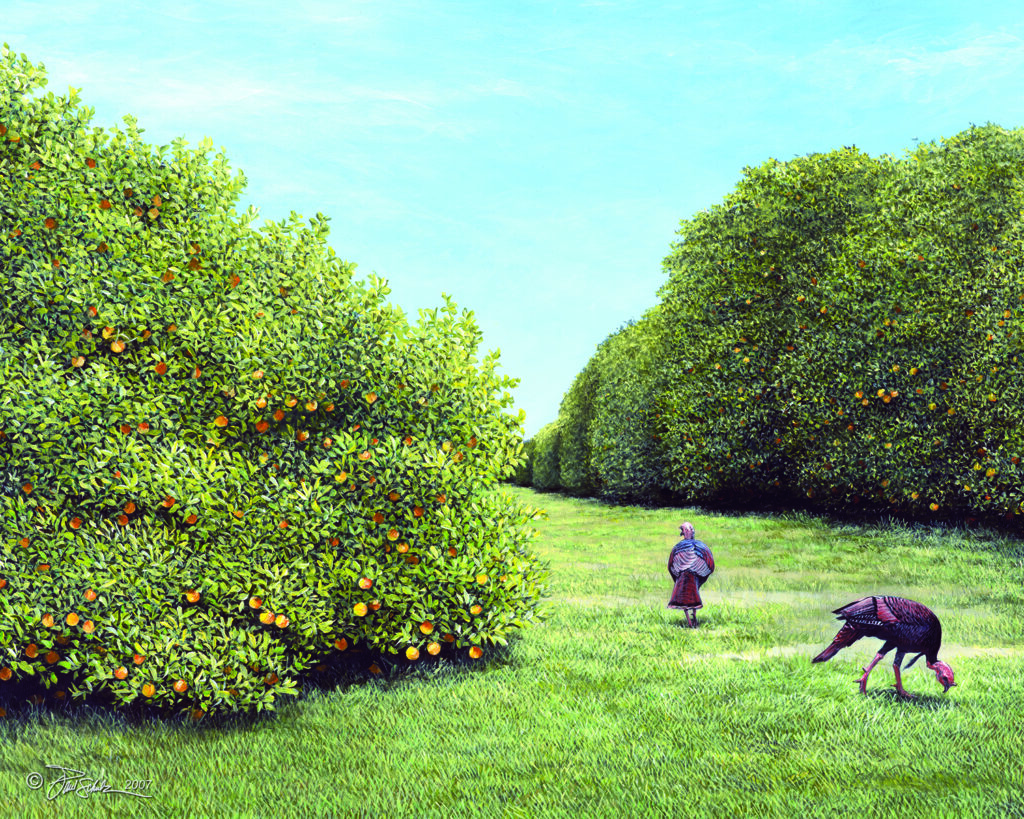Winter Haven Native Paul Schulz Shares his Labor of Love
Paul Schulz is an artist whose work does more than just depict a scene; it reveals the history and influences of the man himself. Not just pretty pictures, Schulz’s artwork is a labor of love that tells any number of stories.[emember_protected custom_msg=”Click here and register now to read the rest of the article!”]
First off, his art speaks of family. The artist, a Winter Haven native, maintains that his love of art was instilled in him early by his maternal grandfather, William Pringle. Pringle was a master engraver with the U.S. Mint and a commercial artist. Schulz recalls drawing and painting with his grandfather even at a young age. When he set off for college as a young man, he majored in economics—something that seemed practical—but he took as many art classes as possible at his alma mater, Davidson College.
And what about his penchant for painting wildlife? That too speaks of family. By his father’s side, Schulz honed his own love of nature and its wondrous flora and fauna; what other boy visits the lumbering giant tortoises of the Galapagos Islands at age 12 or treks through the steaming jungles of the Amazon and Ecuador at 14? The list of places in the world where Schulz hasn’t visited would be the shorter list, and it’s those wild places that have inspired his art. It’s a love that he passes on through his own family; he recently took his own son to watch the Monarch butterflies gather by the thousands in Mexico.
His art also speaks of a few generations’ worth of work and labor, as many of his paintings—especially those depicting citrus—have special meaning for him concerning the family company, Florida Chemical. A producer of citrus oil, Florida Chemical was started by Schulz’s father, and Schulz himself ran the business for over 20 years. Schulz’s painting, Valencia Morning, depicts an orange grove with a White Ibis on the wing—a familiar sight in Florida. It was Schulz’s first painting that combined one of Florida’s most familiar agricultural industries—citrus—with wildlife. Schulz used prints of Valencia Morning as Christmas gifts for customers and suppliers of Florida Chemical; it’s a piece of artwork that is familiar throughout the agricultural industry.
Another painting, Low-Hanging Fruit, also depicts a bird widely known in Florida—a Wood Duck—alongside citrus. Schulz used this painting as a departing ‘thank you’ to those instrumental in Florida Chemical. The company sold last year to Flotek, an international player in the oil industry. Schulz explained that the term ‘low-hanging fruit’ is an industry term that implies a venture or enterprise will have big payoffs—essentially, he explained, that while saying good-bye to the family business was bittersweet, the painting shows that he is confident in Flotek’s ability to take Florida Chemical to the next level.
Retiring from Florida Chemical has allowed Schulz to focus on his art and his next great ambition: conservation. It’s no coincidence that when Schulz’s paintings depict agriculture they also include wild animals. Mankind’s focus on agriculture and the plight of wildlife in that landscape has been a recurring theme here in Florida. Looking back, one of Schulz’s favorite personal accomplishments was illustrating “Under the Panther Moon,” a book by Florida Senator Rick Dantzler. Schulz maintained he was happy to contribute to the collection of stories concerning Florida and its unique set of environmental wonders and challenges.
Looking forward, Schulz still has his eye on art and conservationism. By his own admission, he is painting with brushes and with bulldozers now. He has a few plans in the works concerning parcels of land that would combine the wants of mankind with the beauty of wild things—just like the citrus groves and wildlife in his paintings. In his mind such art is one and the same, and it’s all a labor of love.
CREDITS
story by ERIKA ALDRICH
[/emember_protected]

